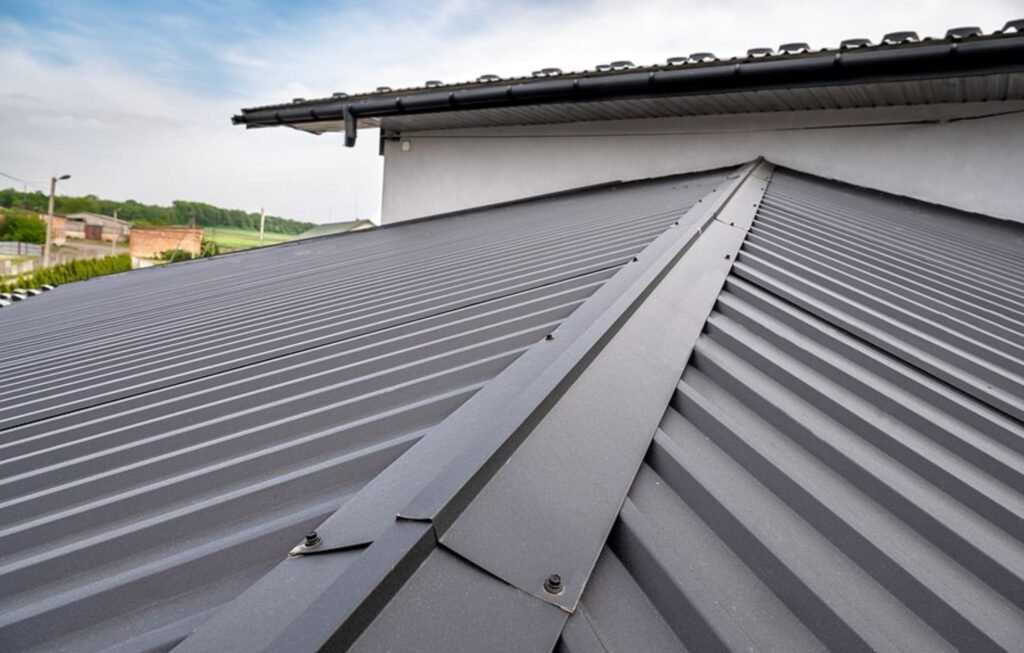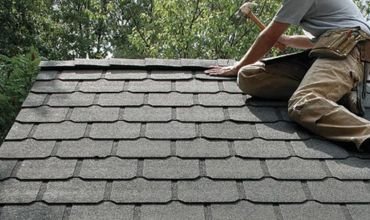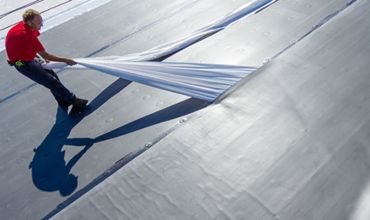Installing a roof on your home or other areas is one of the most important matters in your life as it protects you from harsh weather conditions, heat, and other elements. Many people keep searching for the best roofs but are unable to find the right choice. But do not worry—you have us. If you are making a roof for your new house or want to replace your previous roof, you will learn about the different types of roofing materials in this manual. So, keep reading until the end.

Metal Roofs are generally durable and are offered in various varieties, including metal shakes and shingles, standing seam metal roofing, and stone-coated steel. They are made of copper, steel, or aluminum and last 40-80 years.
These are reflective by nature, which makes them a good option for sunny locations. Additionally, these roofs are not impacted by water, fire, or hail, but they can be quite loud when it rains. These are very lightweight and demand low maintenance. The expenses associated with these materials used for roofing sheets may differ based on the selected style.
Rolled roofing material is the primary choice for low-slope residential roofing and outbuildings like workshops and storage sheds. It consists of extended rolls infused with mineral and asphalt components and covered with mineral granules.
Each roll typically provides coverage of about 100 square feet and has a width of roughly 3 feet. This is the cheapest roofing option on the market, but few variations exist. Most color options are black, gray, tan, or green. Moreover, it is not very durable and has a lifespan of approximately ten years. Therefore, for individuals who value appearance, rolled roofing may not be the most suitable option due to its unappealing nature.
Solar tile roofing has gained popularity in recent years. The design of these tiles focuses on the absorption of solar energy, allowing for its conversion into electricity, thereby offering the potential for savings on energy bills.. They are also lightweight and can protect from rain, hail, and wind. However, installing these roofing types is very time-consuming and can be quite costly. Also, they are not a better option in areas that receive less sunlight. Insufficient sunlight can result in a prolonged payback period for the initial investment, making it difficult to have reduced electricity bills.

Asphalt Shingles are one of the most popular options in North America, as they are cost-effective and very easy to install and repair. The installation itself is efficient, requiring only rolling out and nailing down the shingles. You can select from a range of asphalt shingles, from basic varieties to more premium options, such as 3-tab or architectural shingles.
However, it is crucial to understand that asphalt shingles may not be the most resilient roof material type. Their lifespan can extend up to 30 years, contingent upon environmental factors such as wind and sunlight exposure. Once the granules on the asphalt shingles deteriorate, the entire roofing system must be replaced. Color choices are also limited to black.
Clay tiles are a natural roofing option made from earthen clay, which is shaped and fired to enhance its strength and durability. This is one of the best roofing materials for hot climates and is thus a popular choice in desert and coastal regions.
Clay tiles are highly long-lasting and can last more than a century, but they can be a bit on the expensive side. While they provide a degree of durability, they are notably fragile and may break during maintenance activities. Furthermore, regions with cold weather can be particularly harsh on clay tiles, as the material tends to become more brittle in lower temperatures.
Slate is one of the most durable roofing materials. A soft slate can easily last for more than 50 years, while a hard slate can be durable for around 200 years. This material of roof is one of the most utilized for residential properties as it requires less maintenance and does not need any additional defenses against insects, fire, or water.
Furthermore, this material is very strong and is well known to protect residents from powerful winds and heavy snowfall. But the only drawback is its weight. The slates are very heavy, and some of the roofing structures will not be able to handle their extra weight. These are also very expensive and might not be affordable for everyone.

People who are looking for a substitute for clay tile can choose concrete tile, as these offer the same benefits and installation methods. Also, they are less expensive than clay tiles and have a lifespan of 50 years. These are made from standard sand-mix concrete and can be customized in a wide range of colors.
It requires more maintenance, especially because of its ability to absorb water. Furthermore, it requires regular resealing every few years and is not an ideal roofing material choice in cold areas as it can easily break in harsh winters.
Built-up roofing is commonly used for flat roofs and is one of the most traditional forms of roofing material utilized for this purpose. BUR systems are composed of several sheets of roofing treated with hot asphalt and offer wonderful protection from UV rays, water, and other weather conditions.
It is relatively low-maintenance, cost-effective, and can be easily removed for repairs or replacement. However, the installation process for BUR is very slow and requires more labor. Moreover, these roof covering materials do not provide aesthetic value and are not suitable for pitched roofs.
Wood roofing is one of the most traditional roofing materials that gives an attractive yet simple look. These are also long-lasting, energy-efficient, and a great option for those looking for environment-friendly roofs due to their quick biodegradable nature.
On the other hand, they are quite expensive and require a lot of maintenance. Preserving wood roofing requires time and extensive labor. It generally has a shorter lifespan, with most wood roofs lasting no more than 30 years. It is also essential to acknowledge that certain types of wood roofing may not be environmentally sustainable, as the regrowth period for harvested wood can be considerable.

One of the most common roofing materials for houses with flat roofs is membrane roofing. Several types of membranes can be used to make this roofing material, but the best one is EPDM, a synthetic rubber sheet recognized for its cost-effectiveness, reliability, lightweight characteristics, and ease of installation and repair.
Membrane roofs are vulnerable to punctures, and the seams between the sheets can also lead to leaks. They might not be an ideal choice for those who prefer style and aesthetics over other benefits. They are not very durable and, if maintained properly, have a lifespan of 20-35 years.
Green roofing involves covering your roof with grasses or flowers, creating a garden. This serves as an outstanding heat shield and is ideal for warmer regions that may benefit from enhanced indoor temperature management.
Nevertheless, installing these roof materials in your space can be a bit costly as you will have to ensure that the health of plants does not deteriorate. It demands a lot of maintenance and regular inspections. These can last for 30-50 years and are environmentally friendly.
Synthetic Composite Shingles are an innovative, lightweight, and budget-friendly choice known for their durability. They can easily last for over 50 years. These offer protection from UV radiation and are very effective against hurricanes, fires, and winds. Also, they are not impacted by insects and are less prone to damage that is commonly faced by other kinds of roofing materials.
Those who like variety will definitely love Synthetic Composite Shingles, as they offer a wide selection of appealing styles, including those that imitate slate and cedar shake. Synthetic roofing’s standout features are its low maintenance and longevity.
We have discussed different roofing materials readily available in the market. All of them provide many benefits; therefore, you must choose the one that best suits your needs. You have to keep in mind the climatic conditions of your area as well as your budget. A roof is a big investment and must be selected wisely.
The cheapest roofing material is asphalt shingles. However, some options, such as wood shingles, metal shingles, and slate shingles, may be more expensive but offer more durability.
Clay, slate, and concrete are the most durable roofing materials. They are long-lasting, but you have to check whether they are suitable for your home.
Homeowners looking for an efficient installation experience may find metal roofing an ideal choice. It is regarded as one of the most rapid and easily manageable roofing materials.
Residents in hot regions are advised to select white for their roofing materials, as this color absorbs the least heat, effectively reducing the overall temperature of their roofs and living spaces.
The most common roofing material today is asphalt shingles, as they are affordable. An asphalt roof is fundamentally constructed from asphalt shingles and related materials.
The three most general roof designs in America are hip roof, gable roof, and flat roof.
Although all roofing materials come with their own set of benefits and limitations, metal tiles and asphalt shingles are commonly viewed as the simplest to install.
Metal Roofs. These are long-lasting and protect with minimal effort.
Leave a Reply